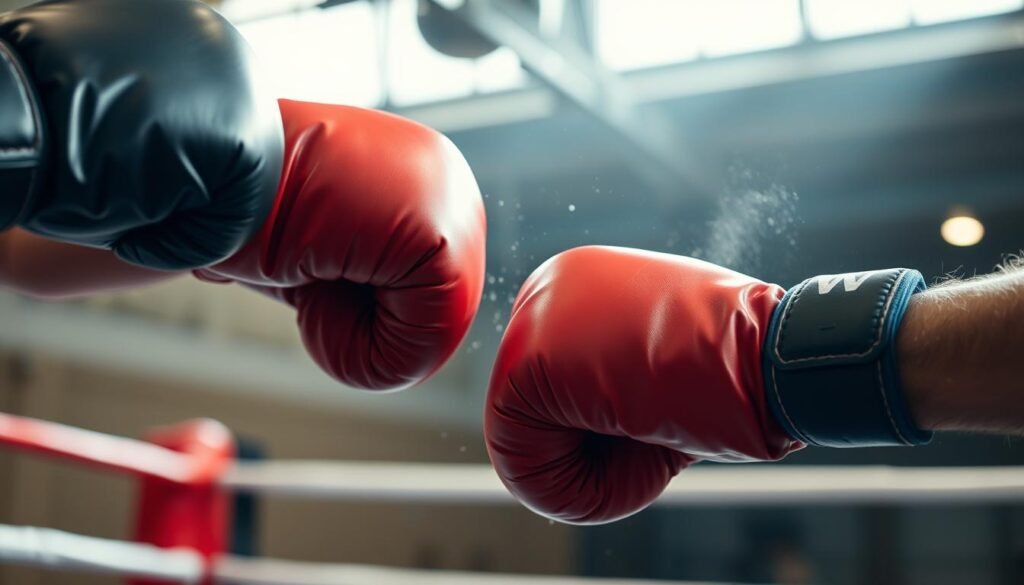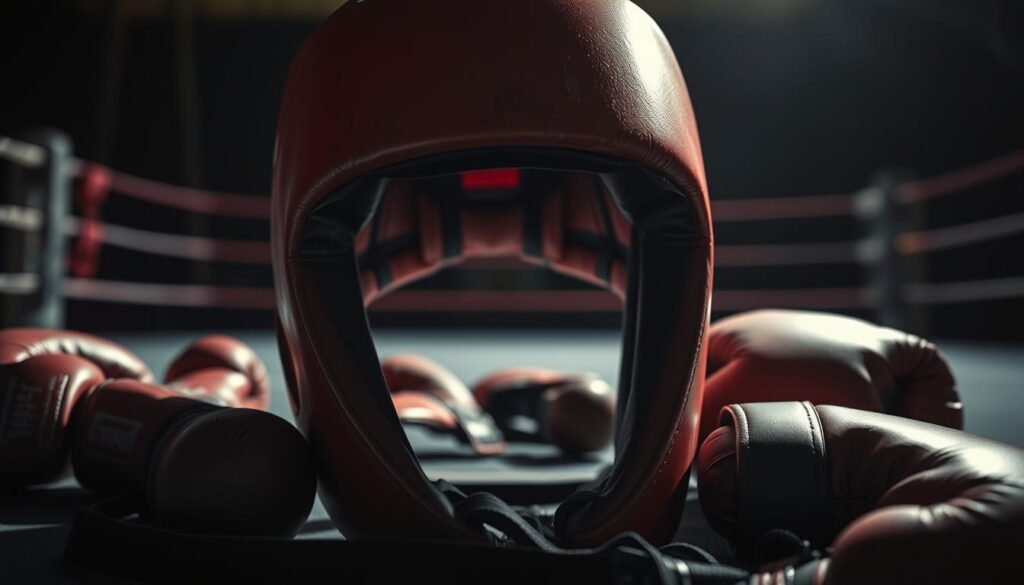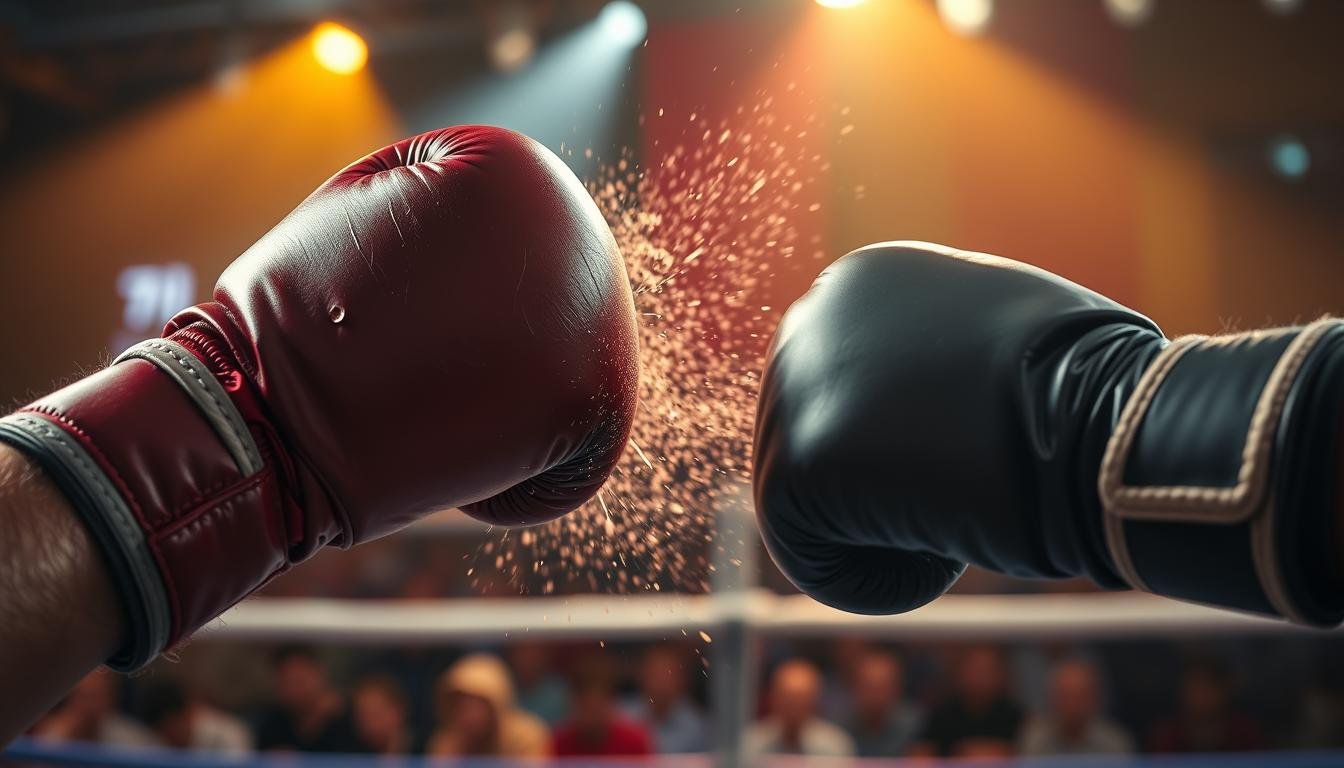In the world of amateur boxing, understanding punch power is key. Punch intensity isn’t the same for everyone. It’s shaped by technique, strength, and how the body moves. We’re going to explore the strength of punches in amateur boxing. We’ll explain why powerful hitting matters. This sets us up for more detailed discussions later.
Key Takeaways
- Amateur boxing punch power is critical for effective performance.
- Punch intensity varies based on individual athlete factors.
- Understanding how hard boxers punch helps in coaching and training.
- Technique plays a vital role in achieving higher punch power.
- Body mechanics significantly influence the effectiveness of a punch.
Understanding Punch Power in Boxing
Punch power in boxing is more than just strength. It’s about speed, technique, and physical might working together. Knowing how a punch works shows us how much impact it can have. This can change the course of a match.
When throwing a punch, many things matter. The body has to use its movement for maximum effect. A sharp hip twist or weight shift can make a punch much stronger. Coaches know this. They work on these details to boost punch power.
Punch power is key, not only for knockouts. It’s a vital part of a boxer’s skills. Getting better at this can make a boxer more formidable. Fighters and coaches use this knowledge to shape their training and fight plans.
Knowing about punch power’s role is crucial. It makes boxers more successful. With this insight, their fighting skills improve greatly.
How Hard Do People Punch in Amateur Boxing
Looking into the strength of punches in amateur boxing reveals some cool facts. Punches range from about 450 to 850 pounds of force. This shows just how strong these athletes can get. The force of a punch can change a lot. It depends on things like the boxer’s weight, how much they’ve trained, and their experience.
Average Punching Force of Amateur Boxers
The average force of a boxer’s punch can vary quite a bit. This happens especially between lighter and heavier weight classes. Below is a table that breaks down the average forces based on weight:
| Weight Class | Average Punching Force (lbs) |
|---|---|
| Flyweight (112 lbs) | 450 – 600 |
| Lightweight (135 lbs) | 550 – 700 |
| Welterweight (147 lbs) | 600 – 750 |
| Middleweight (160 lbs) | 650 – 800 |
| Heavyweight (215+ lbs) | 800 – 850 |
Factors Influencing Punch Power
Several things play into how powerful a punch can be in amateur boxing. The main factors include:
- Body Mass: Heavier boxers tend to hit harder. They have more weight behind their strikes.
- Technique: Knowing the right way to move and hit can really increase punch strength.
- Physical Attributes: Things like how strong, fast, and fit someone is also matter a lot.
- Training Level: The more a boxer trains, the better they get at punching hard.
The Science Behind Impact Force
Understanding impact force in boxing is key for athletes and fans. Amateur boxing science teaches us about force and momentum in a punch. It shows that punching power comes from speed, technique, and how we move our bodies together.
Newtons’s laws of motion help us study impact force. The law of inertia says a moving boxer keeps going until stopped by another force. This tells us keeping up speed is crucial for a strong impact. The law about force shows force equals mass times acceleration. This means a boxer’s punch is stronger with quick and accurate moves.
Boxers use these scientific ideas to get better at training. Learning about punch dynamics improves their technique. This makes them more effective in the ring. By focusing on speed and technique, boxers bring out the full power of their punches, making them more powerful and accurate.
Amateur Boxing Punching Power Techniques
Mastering specific techniques is key in amateur boxing. Proper form is crucial for impactful strikes. It helps athletes boost their performance significantly.
Good footwork improves agility and balance. It lets boxers position themselves to throw powerful punches. Strength from the legs and core adds force to punches.
Controlled breathing increases punch power. It keeps muscles strong and prevents early fatigue. Using these methods in training can greatly enhance punching power.

Practice drills are essential for stronger punches. Shadow boxing and bag work are good for training. Using focus mitts with a partner helps refine strike power and accuracy.
Strength training is also important. It builds up arm, shoulder, and core muscles for stronger punches. These techniques together ensure boxers have the best punch power for their matches.
Key Elements of a Powerful Punch
A powerful punch in boxing comes from technique and body mechanics. To enhance a boxer’s power, one must understand the dynamics of striking. It’s important to focus on body mechanics and effective weight transfer during a punch.
Body Mechanics and Weight Distribution
For a punch to be strong, effective body mechanics are key. How you distribute your weight is crucial. Moving weight from your legs, through your core, and to your arms makes punches hit harder. The steps include:
- Establishing a solid stance: Proper foot positioning allows for effective balance.
- Weight transfer: Shifting weight from the back foot to the front foot provides momentum.
- Hip rotation: Coordinating hip movement generates additional power through the upper body.
Importance of Technique over Raw Strength
Having lots of strength might seem good, but technique matters more for punching. It’s about precise movements and timing. This approach boosts the punch’s strength. Key aspects include:
- Alignment: Keeping your elbow and wrist in line makes your punch stronger and straighter.
- Recoil: Pulling your fist back quickly makes it easier to punch again.
- Breathing: Controlling your breathing at impact helps keep you powerful and focused.
Measurement of Strike Force in Boxing
Measuring punch force is key to better boxing analysis. Many methods help evaluate a boxer’s strike force. For instance, punch monitors and accelerometers give live info on punch speed and force. This tech lets coaches and boxers improve training based on real data.
Measuring accurately is vital for seeing how power affects match outcomes. It helps compare fighters, highlighting what they do best and least. Through striking metrics, boxers can tailor their training to boost their technique and strength.
The following table illustrates various strike force metrics used in boxing:
| Measurement Type | Description | Use Case | Benefits |
|---|---|---|---|
| Punch Monitors | Devices that measure the speed and acceleration of punches. | Analyzing punch speed during training sessions. | Real-time feedback on performance. |
| Accelerometers | Sensors that track the force and impact of punches. | Evaluating performance in sparring or competition. | Detailed insights into punch effectiveness. |
| Force Platforms | Platforms measuring the ground reaction force during strikes. | Studying body mechanics. | Identifying power generation techniques. |
By using these strike force metrics in training and matches, boxers can deeply understand their impact. They can also fine-tune their strategies to achieve better results.
Amateur Boxing Knockout Potential Explained
Knockout potential in boxing involves several key elements. In amateur boxing, knockouts can stem from punch technique, speed, and how an opponent reacts. Boxers aiming for victory should learn effective knockout strategies. This will improve their performance and lead to wins.
Understanding Knockouts in Amateur Matches
A knockout happens when a boxer can’t continue after a punch. A knockout punch needs precise aim and strong force. It’s important to know how these punches work. Timing and angle greatly affect a punch’s knockout power.
- Targeting Vulnerable Areas: Hits to the chin or temple can greatly up the chance of a knockout.
- Development of Sudden Power: Boxers should work on building quick, powerful strikes to surprise their opponent.
- Combination Punching: Delivering a flurry of punches can open up knockout chances.
- Footwork and Angles: Good movement helps boxers position themselves to land winning punches.
Henry Cejudo, an Olympic gold medalist and UFC champ, highlights the value of understanding knockouts. By analyzing opponents and using the strategies mentioned, amateur boxers can up their game. This leads to better performances and more wins in the ring.
Risks of Head Trauma in Amateur Boxing
Amateur boxing comes with challenges, especially the risks of head trauma. Athletes need to know about the injury risks. These can affect their health long-term. It’s vital to be aware of concussion risks to improve boxing safety and health.
Exploring Concussion Risks
Studies show concussions are a big worry in amateur boxing. The rates of concussions vary, but many boxers get head injuries in matches. It’s critical to understand these risks. This knowledge promotes safety and helps in setting up good safety measures. Educating about head trauma and using tools like brain injury assessments can lower these dangers. Genetics also affect how concussions impact boxers.
Long-term Effects of Head Trauma
The long-term impact of head injuries in boxing can be harsh. It leads to conditions like CTE and brain function issues. Knowing the risks of repeated injuries is key to protect boxers. They might suffer major changes in life quality due to ongoing head trauma. Research is being done to find ways to improve boxing safety and health. The goal is to keep the sport safe for everyone involved.

Safety Regulations in Amateur Boxing
Amateur boxing puts safety first with a set of rules. These rules help lower risks but keep competition alive. Protective gear is a must, and referees play a key role in keeping things safe.
Protective Gear Requirements
All fighters must wear proper protective gear. This gear is crucial for their safety during fights. The required gear includes:
- Headgear: Protects the head and lowers the chance of serious accidents.
- Gloves: These must have enough weight and cushion to protect both the fighter and their opponent.
- Mouthguards: Key for keeping teeth safe and reducing concussion risks.
Following these gear rules makes boxing safer. It also builds a culture of care and respect among fighters.
Role of Referees and Officials
Referees have a big job in enforcing safety rules during matches. They have to:
- Watch for proper use of safety gear.
- Stop a match if a fighter looks hurt or can’t go on.
- Make sure all the rules are followed for a fair, safe fight.
Officials also teach boxers about staying safe. With careful watch, referees make sure all matches are safe and fair.
Knowing these safety rules helps boxers stay safe. This way, they can enjoy the sport without worrying too much about getting hurt.
Understanding the Role of Protective Gear
Protective gear in boxing is key for an athlete’s safety, especially in amateur boxing. It is designed to cut down injuries during training and matches. Each piece has a special role in impact mitigation. This lets boxers train safely and get better at their sport.
Types of Protective Equipment
Amateur boxers need different kinds of protective gear. Here are the main types:
- Headgear: It prevents cuts and bruises by absorbing shock, especially during sparring.
- Gloves: Designed to spread impact force, these protect hands and wrists and soften blows to opponents.
- Shin Guards: These guard the lower legs against harmful strikes, used often in training and competition.
- Mouth Guards: Essential for teeth protection and reducing concussion risk by cushioning impacts.
How Gear Mitigates Impact Force
Properly fitting gear lessens injury risk for amateur boxers. It absorbs and disperses the energy from punches, crucial for impact mitigation. The gear’s design and fit are key. Keeping it well-maintained ensures it works best to protect athletes.
| Equipment Type | Purpose | Impact Mitigation Feature |
|---|---|---|
| Headgear | Protects the head and face | Shock absorbing padding |
| Gloves | Protects hands and cushions punches | Thick foam padding |
| Shin Guards | Protects legs from strikes | Reinforced structure |
| Mouth Guards | Protects teeth and jaw | Shock-absorbing material |
Training for Power in Amateur Boxing
Building powerful punches in amateur boxing needs dedication. Focused exercises are key to stronger punches. These workouts improve muscle power, speed, and technique, vital for winning.
Exercises to Enhance Punching Strength
To punch harder, include specific exercises in your training. Here are some great ones:
- Heavy Bag Training: A classic for more punch force and stamina.
- Resistance Band Punches: Boosts speed, coordination, and muscle strength.
- Medicine Ball Throws: Improves explosive power and punch technique.
- Weightlifting: Builds strength in arms and shoulders for better punches.
Importance of Sparring in Developing Power
Sparring is key in amateur boxing for power development. It’s where you practice techniques against an opponent. It shows how strong your punches are. Plus, it boosts your timing, accuracy, and confidence, making you powerful in fights.
Sparring offers experience you can’t get training alone. It prepares you for real competitions.
| Exercise | Main Benefits |
|---|---|
| Heavy Bag Training | Increases striking power and builds endurance. |
| Resistance Band Punches | Enhances speed and coordination. |
| Medicine Ball Throws | Develops explosive power and improves technique. |
| Weightlifting | Strengthens muscles critical for powerful punches. |
Conclusion
The journey into amateur boxing’s punch power shows a world where technique, body mechanics, and mental strength meet. It’s not just about how strong you are. Learning the right way to punch and training smartly are key. This article shows that there’s a lot to think about in delivering a powerful punch.
Looking at the dangers, like head injuries, we see how vital safety rules are. Wearing the right gear helps protect boxers. So, it’s important for fighters to take safety seriously in their training. Understanding punch impact shows us why being strong and safe matters in boxing.
Getting better at punching by doing special exercises and practice fights helps boxers grow their skills and confidence. As boxers get better, they should remember the tips from this article. Focusing on skill, safety, and strength will help them succeed in amateur boxing’s exciting world.
















